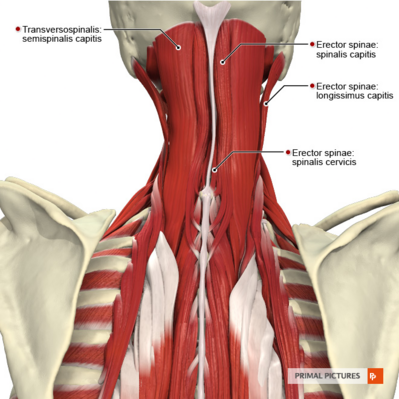Spinalis Capitis: Difference between revisions
No edit summary |
No edit summary |
||
| Line 5: | Line 5: | ||
</div> | </div> | ||
== Introduction == | == Introduction == | ||
[[File:Muscles of the cervical region intermediate muscles Primal.png|thumb| | [[File:Muscles of the cervical region intermediate muscles Primal.png|thumb|399x399px|alt=|Top R arrow Spinalis Capitis]] | ||
The erector spinae group is the intermediate layer of the intrinsic [[Back Muscles|muscles of the back]]. The erector spinae consists of three subgroups, with the group divisions occurring by location. | The erector spinae group is the intermediate layer of the intrinsic [[Back Muscles|muscles of the back]]. The erector spinae consists of three subgroups, with the group divisions occurring by location. | ||
| Line 14: | Line 14: | ||
Spinalis Capitis (or Spinalis Colli) is the most superior of the spinalis group of muscles with [[Spinalis Cervicis|spinalis cervicis]] and [[Spinalis Thoracis|spinalis thoracis]] lying inferiorly in the cervical and thoracic spine. It is not a truly separate muscle, when it exists it consists of occasional fibers from the semispinalis capitis, but with a different insertion<ref name=":1" />. It is known as spinalis capitis due to its attachments to the head (cranium).<ref name=":0">Spinalis muscle [Internet]. Kenhub. 2021 [cited 30 November 2021]. Available from: https://www.kenhub.com/en/library/anatomy/spinalis-muscle</ref> | Spinalis Capitis (or Spinalis Colli) is the most superior of the spinalis group of muscles with [[Spinalis Cervicis|spinalis cervicis]] and [[Spinalis Thoracis|spinalis thoracis]] lying inferiorly in the cervical and thoracic spine. It is not a truly separate muscle, when it exists it consists of occasional fibers from the semispinalis capitis, but with a different insertion<ref name=":1" />. It is known as spinalis capitis due to its attachments to the head (cranium).<ref name=":0">Spinalis muscle [Internet]. Kenhub. 2021 [cited 30 November 2021]. Available from: https://www.kenhub.com/en/library/anatomy/spinalis-muscle</ref> | ||
== | == Anatomy == | ||
'''Origin''' | |||
Spinous process of C7 -T1.<ref name=":0" /> | Spinous process of C7 -T1.<ref name=":0" /> | ||
'''Insertion''' | |||
Near the midline between superior and inferior nuchal lines of occipital bone. | Near the midline between superior and inferior nuchal lines of occipital bone. | ||
'''Nerve and Blood Supply''' | |||
Lateral branch of the rami of cervical spinal nerves (C1 to C3). <ref name=":0" / | Nerve: Lateral branch of the rami of cervical spinal nerves (C1 to C3). <ref name=":0" /> | ||
Blood: Muscular branches of the vertebral artery via the subclavian and also from muscular branches of the occipital artery via the external carotid artery.<ref name=":0" /><br> | |||
Muscular branches of the vertebral artery via the subclavian and also from muscular branches of the occipital artery via the external carotid artery.<ref name=":0" /><br> | |||
== Action == | == Action == | ||
Revision as of 02:06, 4 February 2022
Original Editor Oyemi Sillo
Lead Editors - Abbey Wright, Lucinda hampton, Oyemi Sillo, Kim Jackson and WikiSysop
Introduction[edit | edit source]
The erector spinae group is the intermediate layer of the intrinsic muscles of the back. The erector spinae consists of three subgroups, with the group divisions occurring by location.
- Spinalis subgroup is the most medial
- Longissimus subgroup is between spinalis and iliocostalis
- Iliocostalis subgroup is the most lateral[1]
Spinalis Capitis (or Spinalis Colli) is the most superior of the spinalis group of muscles with spinalis cervicis and spinalis thoracis lying inferiorly in the cervical and thoracic spine. It is not a truly separate muscle, when it exists it consists of occasional fibers from the semispinalis capitis, but with a different insertion[1]. It is known as spinalis capitis due to its attachments to the head (cranium).[2]
Anatomy[edit | edit source]
Origin
Spinous process of C7 -T1.[2]
Insertion
Near the midline between superior and inferior nuchal lines of occipital bone.
Nerve and Blood Supply
Nerve: Lateral branch of the rami of cervical spinal nerves (C1 to C3). [2]
Blood: Muscular branches of the vertebral artery via the subclavian and also from muscular branches of the occipital artery via the external carotid artery.[2]
Action[edit | edit source]
Bilaterally extends the cervical spine and head.
Unilaterally spinalis capitis laterally flexes and rotates the cervical spine and head to ipsilateral (same) side[3].
Function[edit | edit source]
Spinalis capitis works with the other spinalis and greater erector spinae muscles to produce cervical extension as well as lateral flexion and rotation of the spine and head.
References[edit | edit source]
- ↑ 1.0 1.1 Radiopedia Erector spinae group Available: https://radiopaedia.org/articles/erector-spinae-group?lang=us(accessed 4.2.2022)
- ↑ 2.0 2.1 2.2 2.3 Spinalis muscle [Internet]. Kenhub. 2021 [cited 30 November 2021]. Available from: https://www.kenhub.com/en/library/anatomy/spinalis-muscle
- ↑ Spinalis Cervicis : Wheeless' Textbook of Orthopaedics [Internet]. Wheeless' Textbook of Orthopaedics. 2021 [cited 30 November 2021]. Available from: https://www.wheelessonline.com/bones/spine/spinalis-cervicis/







